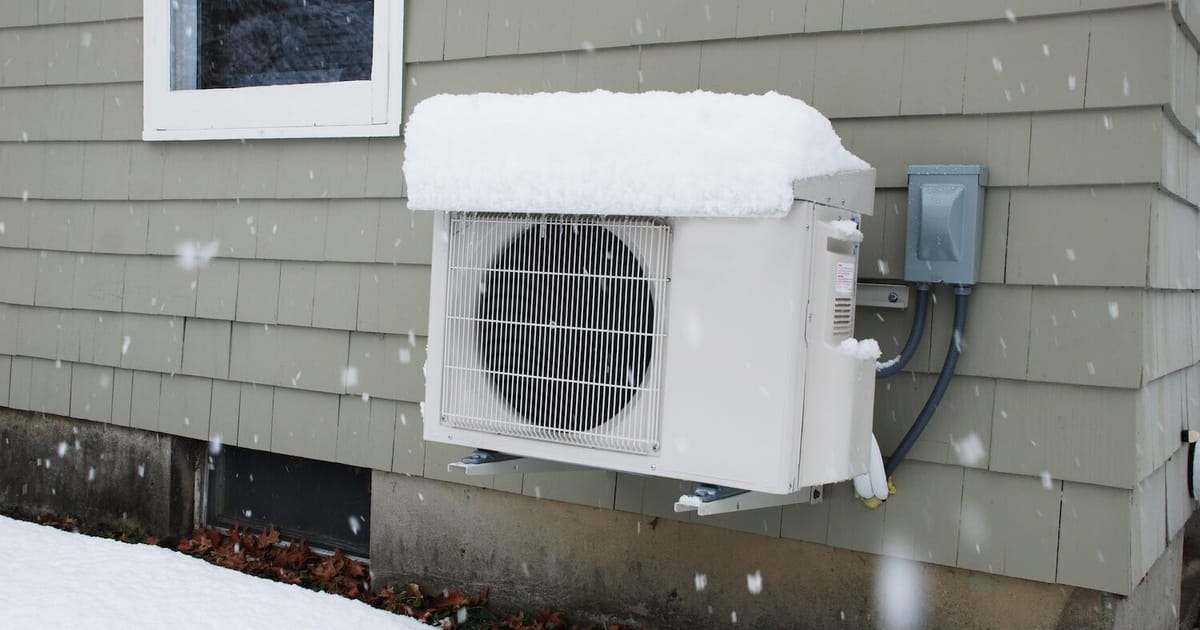Heat pumps sold so fast in Maine, the state just upped its target::undefined
Heat pumps = simply running your AC in reverse
It escapes me such a simple concept could take so long to be considered for homes instead of radiators
These things have been completely standard fixtures elsewhere in the world for decades. I was honestly shocked that America, the land of air conditioning, had never heard of them.
They’re so ubiquitous in Australia it’s what we think of when we hear “air conditioner”.
When you shop for aircons they have to specify “cooling only” because reverse cycle is the default.
They are completely standard in large parts of the US too–just the northeast and other colder areas haven’t started using them due to their colder winters.
deleted by creator
Reverse-cycle ACs have had >100% heating efficiency since the 1990s. America just seems to take forever to embrace anything environmentally friendly (reverse-cycle AC, solar hot water, rooftop solar, etc…).
It wasn’t until somewhere in the last 15 years that air type type heat pumps, as opposed to ground loop, could cope with the cold temperatures in the northern states without having to fall back to resistive heating for weeks at a time.
When you have to run resistive heaters the electrical usage skyrockets and makes a heat pump system vastly more expensive to operate.
If you live in a cold State, Zone 6 or higher, then you need to be careful when purchasing an ASHP to make sure that it has an HSPF of 10 or greater. If it doesn’t then you’ll be paying big electrical bills trying to keep your home warm. Those units are also more expensive to purchase than a regular Heat Pump like you would run down under.
Frankly nowhere in Australia experiences cold anything like what I do on a yearly basis. The coldest temperature ever recorded anywhere in your country was a mere -9f. Here in the United States there’s quite a few places where that is a common daytime high temperature in the winter, even in the lower 48. There’s quite a few places even in Zone 5, see previous map, that will get to -9 and stay there for days at a time.
It’s not uncommon for overnight lows in Zone 6+ to hit -20f and temperatures even lower are definitely possible. At my house in Wyoming last winter we touched -40f / -40c for a some hours one night.
Air type heat pumps simply could not handle those kinds of temperatures until relatively recently. That’s why so much of the US doesn’t have them already. They just didn’t work during the winter in northern half of the country.
When you have to run resistive heaters the electrical usage skyrockets and makes a heat pump system vastly more expensive to operate.
More expensive than a heat pump without a backup/additional electrical resistance heater. Not more expensive than an electrical resistance heater on its own.
That’s what’s so strange about this, in most cases a heat pump would be replacing a non-reversible AC and an electrical resistance heater or gas-fueled furnace. And in nearly every case, even with the need for a backup/additional resistance heater, you’re still saving money. And it’s not like any of this is new technology, it just took forever for it to become popular in the US.
deleted by creator
deleted by creator
Lots of houses in the US have heat pumps already.
This is about one state in the far north pushing to get them into more houses. Older heat pumps would not have been very effective there for most of the winter. Newer models can still produce heat in much colder temperatures, so they are adopting them.
We have them in Florida. It’s just very cold in the Northern USA.
It’s a simple idea, but it’s not quite that simple.
When it gets to be around freezing outside, you have to deal with frost buildup on the outdoor unit.
And as temperatures fall, output and efficiency generally falls. So you need an oversized unit to heat your house on the coldest days, but an oversized unit isn’t great the rest of the year.
Historically, heat pumps were only good if it never got down below freezing. Now, modern cold- climate heat pumps are efficient well below freezing and Mitsubishi’s models advertise that they deliver 100% of their output down to -23F/-30C. Between adding variable inverters, better defrosting, etc they’ve come a really long way in the past decade.
It gets below zero in the north east in the winter. Heat pumps stop working at 20-30F and the system has to switch to classic/emergency heat. They are great for fall/spring (or summer as an AC), but useless for winter.
The bigger issue is that it is extremely expensive to install ductwork, wiring for 1 or more thermostats, and a shiny new heating/cooling system in many existing homes that use classic radiator heat. Depending on where the oil tank is located, it may require removal as well (example: if it is underground, depending on state/municipal laws).
That’s not necessarily true now the newer systems can go to as low as -15F which in the north only happens for a few hours a year so still a reduction in heating gas/oils needed
…which in the north only happens for a few hours a year…
I know the guy in the TC video used Chicago as an example but the “few hours a year” thing simply isn’t true for many of us.
Where I live we had many days below -15f including a week where itpretty much stayed between -20 and -30 for nearly a week straight.
A Heat Pump will still work, even here, but you need to be careful about which one you purchase and how it handles cold weather.
Or remember when it “felt like” - 50° F for two days straight that one February?
I had to start my car up twice every night to keep the battery from dying.
First off, as the other poster replied, that isn’t true about modern heat pumps. They continue to work below freezing, and many support an “eheat” resistive heating mode, obviously only good if you still have electricity, but that’s true of all heat pumps. Generators or solar+batteries become much more important.
But the beauty of heat pumps is that you don’t need to install ductwork. Look at mini splits. You can do zoned or single room installs. No ductwork required. One of the huge upsides of mini splits are you do get “instant” zoning. You can stop heating and cooling unused rooms to a human comfortable temperature.
You can also get systems that retrofit into existing forced air ductwork.
I wouldn’t be surprised if someone made or will make a heat pump water heater for hydronic radiators.
You can also run the element that is typically outdoors inside if you have enough space in a basement, for example, which stay a pretty consistent temperature all year long.
Man this was a wild ride on this comment chain. At first I was sad, because I don’t have ductwork, now I am excited because I was eyeing a mini-split for our AC anyway. Yay!
Yeah, just get one with reversing valve so you can switch between heating and cooling cycle. Well more like switch around where the heating an cooling cycles happen.
Minisplit doesn’t matter since actually almost all of the process happens on the outside unit. What goes inside is the fluid lines(refrigerant feed and return), condensation water line out from the inside and a control data cable from the inside blower unit to the outside operative unit. Outside unit switching around what stage of the fluid cycle gets fed to the inside going line, changes purpose between cooling and heating. Oh yeah and the inside unit also has an electric fan and nozzles to make the airflow happen.
edit: What often mislead is people designating one and other of the coils as evaporator and condenser depending on choosing which mode is “default”. Even manufacturers materials. However with 4-way diverting valve unit there is no dedicated evaporator and condenser. There is just two heat exchanger coils. Inside located coil and outside located coil. It is completely upto the valve position and flow diversion, as which is which. Each is always one or the another, but which is which is depending on the valve position. The system is equally as happy air-conditioning the outside or the inside. Thus in match heating the inside or the outside.
Heat pump and AC are the same thing. AC is just specific name for use case of heatpump, where the cold coil (evaporator) is inside and the hot coil (condenser) is outside.
Wait a minute… so I can just turn my window unit 180 degrees in the winter? Joking… sort of. Would that work, at least for a while (in theory, I am not actually weird enough to try it)
It probably wouldn’t run because the air its ingesting to cool is already cold, but if you bypassed the thermostat, sure.
Because they’re not designed to work that way I’m sure their efficiency would be low/non existent in actually cold temps.
Early heat pumps could only work to like 30F or so. New ones are much, much better.
Well it would probably “pee” on your floor. Since typically window unit air conditioners have condensation water tube going to outside edge and just letting it drip out. The condensation water after all has to go somewhere. Minisplits actually usually have a third line going out for that along with the refrigerant lines. Fluid in, fluid return and then condensate waterline for, when the inside is cooling and thus generating condensation.
Otherwise? It probably isn’t winterized, but theoretically… heat pumping is heat pumping. It would try to cool the outside air and thus heat inside. Though its thermostats probably would need tweaking. Don’t think those have setting for “please cool down to -15C”. Meaning in practice it would never run, since ambient already is constantly below its minimum temperature. Though as I remember most arcane old units didn’t have such fancy feature as thermostat. You just turned them on, they would pump at their full capacity constantly and you were yourself supposed to be the thermostat by turning the power switch off, when you didn’t want any more cooling.
I got a quote last year as my furnace is original to the house (33 years old) and we don’t have AC.
It was going to be $25,000, $5k of which was installing new ductwork because the existing ducts aren’t insulated enough.
Easy pass. I’ll wait for prices to (hopefully) come down.
It’s probably not gonna come down.
I’m in HVAC, the industry is insane right now with the cost of equipment alone, let alone the hourly rate for the installers.
Honestly, 25k for a complete overhaul is probably the lowest you’re gonna get.
I’d look into mini split heat pumps. Ditch the ducts all together, and you’ll probably save a few grand.
The last time I did a quote for a house in the northeast it came in at over 50k all-in. Oil tank had to be removed which would have costed a ton…the state would only pay for part of it. New ductwork run, baseboard heating removed (pipes sawed off and capped at wall), hot water heater added, new heat pump with dual zone + thermostats for upstairs/downstairs. Plumbing modifications for new setup including a new hot water line for reasons I can’t remember. Drywall ripped out, replaced, painted, etc.
3 different quotes for over 50k. I sold the house instead. No thanks.
My current place (not in the northeast) has a heat pump and our electric bill is never over $200 for a 2,200 sq ft home, so they will definitely save you money. That up front cost can be a killer, however. We had the heat pump stop working once and had to use emergency heat for about a month and our electric bill more than doubled.
That is refrigerant dependent. For example R744 (plain old CO2) works well efficiently down to -4F, -20C and down to -40C/-40F just with some efficiency drop.
Main issue is CO2 needs a constant high pressure heat pump system, since it needs to be highly pressurised to be fluid at all. In ambient it sublimates (goes straight between gas and solid aka dry ice).
However that is a solved issue. Working CO2 heatpumps are off the self commercially available these days. Just still little more expensive as I understand. However prices should come down with production economies of scale, upon CO2 taking over due to pollution, toxicity, flammability, green house considerations. He nastier chemicals weren’t used for being all the ways superior, but due to it being easier to make the heat pump units (be they running in heating or in cooling) due to lower pressure requirements.
Since CO2 and ammonia were the original refrigerants. Used in large ice production facilities early on, where their specific needs weren’t issue even for earlier technology. Large, purpose built, stationary industrial facility had no problem accommodating the needed massive pressures by just really massive and heavy pipework.
However these days the propeller head people developed micro channel tubing and heat exchangers to keep the high pressure CO2 in control.
Heat pumps stop working at 20-30F
Yeah crappy ones. This does not apply to the ones designed for cold climates. Mine still beats electric radiators in efficiency at -22f
In Scandinavia we run ours down to -4F or colder. Efficiency goes down but they are still better than 1:1 until then.
Average temperatures for Bangor, Maine in January are colder than the average temperatures for January in Stockholm, Sweden.
Still within range of a good heat pump but Scandinavian countries don’t have a lock on cold. January averages where I live in the US are colder than Reykjavik, Iceland!
Well… Iceland has ocean warmth due to gulf stream and is a literal vulcanic Island. Heck Island doesn’t have heating problems, they just capture heat from the hot springs created by the vulcanism.
As such Iceland is kinda misleading as is Greenland. Iceland has less ice than greenland. Though Iceland is not green, more like black given all the volcanic basalt.
Average January temps where I live are lower than Stockholm. I chose Reykjavik because it’s a neat place, not because it was particularly cold. :)
I’ve spent a quarter of my life in Australia and never seen heat in a house (which is nuts, because Melbourne and Hobart winters are pretty close to Vancouver winters omit the one week of snow we get here in Canada).
The benefits of having hot water and heating from the same source I’d guess
I’ve never seen anyone using their furnace to run hot water. Radiator water loops are closed loops and I’m sure you wouldn’t want that water to be used for anything you’d use hot water for.
I think it’s mostly a factor of ACs weren’t historically efficient. They were all on or all off. In the more recent designs that are ultra efficient they use variable speed compressors.
They were also historically less reliable than a furnace and certainly more difficult and complicated to service.
Combination boilers are incredibly popular in Europe.
It’s kind of amazing that with a radiator you turn 1kW of electricity into 1kW of heat energy but with a heat pump depending on the efficiency you might get 2kW of heat or even more with the same amount of electricity.
Not really. Heat pump is not creating heat unlike resistive heater. It’s just transporting it. One must remember even though freezing temperatures are cold for humans, for physics and universe those are still relatively high temperature environment. After all 0 Celsius is 273 positive Kelvin degrees. So that is 273 Kelvin forth of heat to pump around. Well say in -30C, still 243 K worth of heat to pump around. So the issue isn’t is there heat, the issue is the practical mechanical and thermodynamic realities of he pumping. Which in practice comes down to can you find suitable refrigerants with suitable phase change characteristics to pump around.
Which for normal ambient temperatures on Earth is “yes”. Just usually matter of how high pressures one has to use and other nasty features of the materials. For example recently even just CO2 has been started to use more again, issue with it mostly being it has to operate at higher pressures than more traditionally used refrigerants. They just don’t call it CO2 in the bizz, it’s refrigerant fluid R744. That works down to -56.6 Celcius given its triple point temperature. So it won’t heat one in antarctic -80C winter, but for most of Earth even in cold climates -56.6 C is plenty. Problem just is it has to always work under high pressure, since in ambient pressures CO2 just sublimated from solid to gas. Pumping around solid blocks of dry ice isn’t very convient for continuous heat exchange process machine.
Which adds some cost to the pump components. On the other hand… CO2 is pretty darn harmless. As long as concentration locally isn’t too high, humans, animals and plants are perfectly used to handling the gas they exhale. It is non flammable, it is green house gas, but it is green house gas we naturally exhale. Some unit leaking it doesn’t change much, since usually CO2 for industrial use is extracted from waste product gas, that would end up in air anyway.
Plus on need be it can be distilled from air, it’s just energy intensive. Which is why “carbon capture” isn’t a bigger thing. We know how to do carbon capture. It’s just energy intensive and thus on climate impacting massive scale energy prohibitive.
deleted by creator
Is this the reason why they’re so expensive?
Just had a 48btu unit installed. 2,000 sqft, 3 - 9k wall units, 1 - 18k ducted unit. Operational down to -22 F.
$20,000 and then a $4,300 rebate and later a $2,000 tax credit. Down right affordable. Would have been even less if new ductwork didn’t have to be retrofitted.
There are many rebates for their installation. Check your city, state, federal, and utility for kick backs. That’s having a huge effect on demand.
I am confused. I though heatpumps required you to drill down far underground and pump up warm air while pumping down cold. This article makes is sounds like people are just installing A/C units in backwards. Don’t you need to drill something for heatpumps?
Nah man you’re thinking of geothermal systems. Heatpumps is just an AC that among other things can reverse the cold and hot sides so that it also heats the living area
I watched the technology connections video. So I should know. But I don’t really know. What’s the difference between a heat pump and a split air conditioner?
💀








